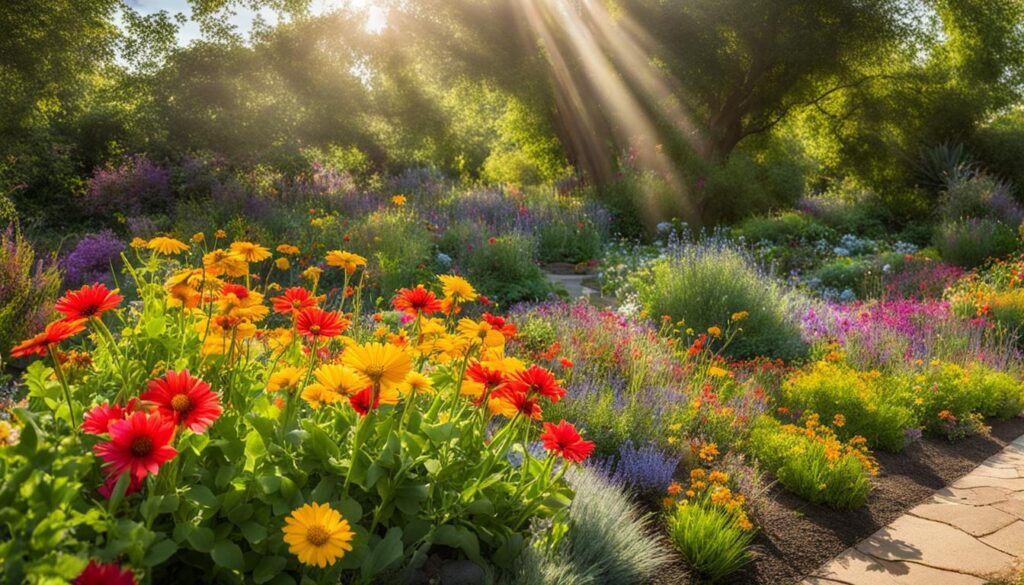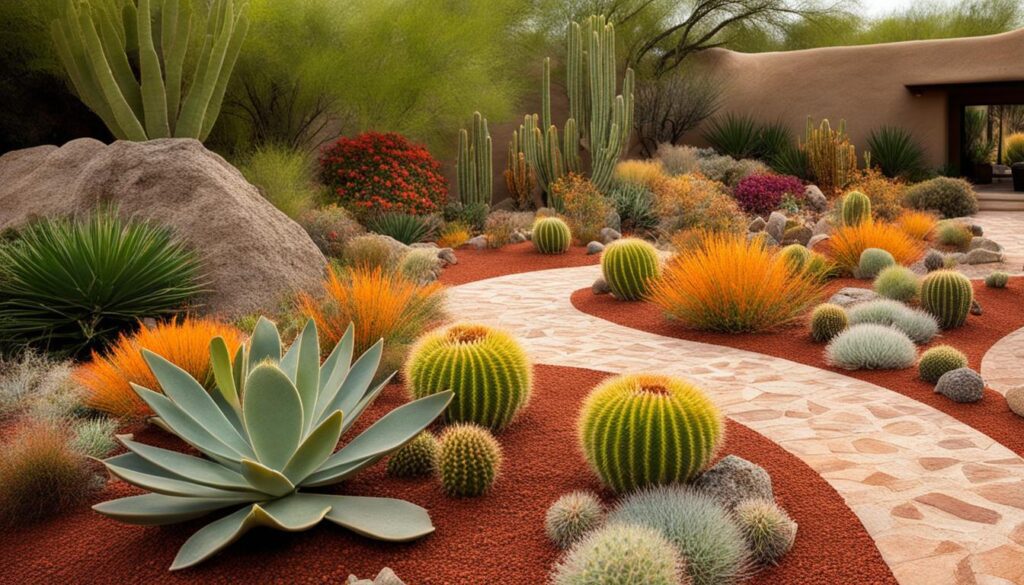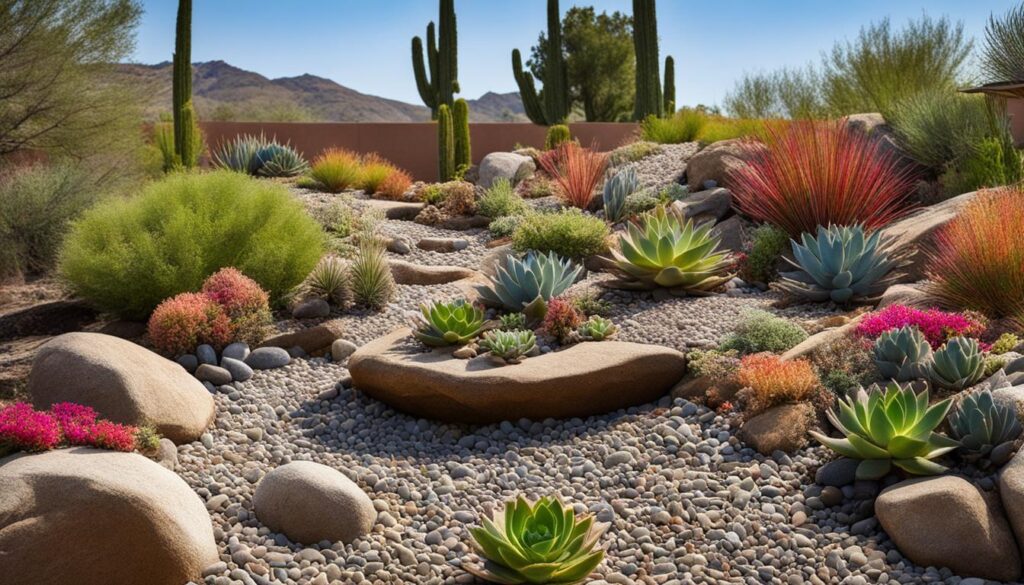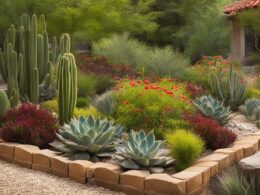Xeriscaping is a landscaping design that aims to conserve water by using drought-tolerant plants and minimizing the need for irrigation. Proper maintenance is essential for keeping a xeriscape thriving. Here are some important tips for maintaining and caring for your xeriscape:
Key Takeaways:
- Regularly monitor and adjust irrigation systems to ensure efficient water use.
- Apply mulch to retain moisture and suppress weed growth.
- Prune and trim plants as needed to maintain their shape and health.
- Monitor soil moisture levels and water only when necessary.
- Remove weeds promptly to prevent competition for resources.
Benefits of Xeriscaping
Xeriscaping offers a multitude of benefits for both homeowners and the environment. By implementing a water-efficient landscape design, you can enjoy the following advantages:
- Water Conservation: One of the primary benefits of xeriscaping is its ability to conserve water. By using drought-tolerant plants and minimizing the need for irrigation, xeriscapes can significantly reduce water usage compared to traditional landscapes.
- Cost Savings: Xeriscaping can also lead to cost savings in the long run. With reduced water consumption, homeowners can expect lower water bills. Additionally, xeriscape maintenance typically involves less time, effort, and resources, resulting in potential savings on maintenance costs.
- Environmental Impact: Implementing xeriscaping practices can have a positive environmental impact. By conserving water, xeriscapes contribute to water resource preservation and help alleviate the strain on local water supplies, especially in arid regions. Furthermore, xeriscaping reduces the need for chemical fertilizers and pesticides, promoting a more eco-friendly approach to gardening.
With its water conservation benefits, potential cost savings, and positive environmental impact, xeriscaping is an attractive option for homeowners seeking a sustainable and visually appealing landscape.
Emphasizing the Importance of Water Conservation
“Xeriscaping not only saves water but also promotes responsible water usage. By reducing the reliance on irrigation, homeowners can play a vital role in water conservation efforts and ensure the long-term sustainability of our water resources.” – Water Conservation Expert
By implementing xeriscaping techniques, you can actively contribute to water conservation while creating a beautiful and low-maintenance landscape that thrives in various climates. The next section will explore the principles of xeriscaping, guiding you in the design and implementation of a water-efficient landscape.
Principles of Xeriscaping
Xeriscaping is not just about using drought-tolerant plants; it is a comprehensive approach to landscape design that promotes water conservation and sustainability. By incorporating the following principles into your xeriscape, you can create a beautiful and eco-friendly outdoor space:
- Efficient irrigation: One of the main goals of xeriscaping is to minimize water usage. Consider installing a drip irrigation system that delivers water directly to the roots of plants, reducing evaporation and run-off.
- Soil improvement: Healthy soil is crucial for xeriscapes. Amend your soil with organic matter to improve water retention and nutrient availability for plants.
- Drought-tolerant plants: Select plants that are well-adapted to your climate and require minimal watering. Native plants are often a great choice as they are naturally suited to the local conditions.
- Appropriate turfgrass reduction: Grass lawns can be water-intensive. Consider reducing the amount of turfgrass in your xeriscape by incorporating alternative ground covers, such as gravel or mulch, or creating functional areas with hardscape features.
- Mulching: Applying a layer of organic mulch around plants helps retain moisture, suppresses weed growth, and regulates soil temperature, reducing the need for frequent watering.
Designing a Xeriscape
When designing your xeriscape, keep in mind the following considerations:
- Grouping plants: Cluster plants with similar water and sun requirements together to create efficient irrigation zones. This allows you to tailor watering schedules and prevents over or underwatering.
- Creating microclimates: Use taller plants to provide shade and windbreaks for more delicate plants. This helps create microclimates within your xeriscape, reducing water loss and protecting plants from extreme weather conditions.
- Adding focal points: Incorporate focal points, such as a garden sculpture or a water feature, to enhance the visual appeal of your xeriscape. These elements can draw attention and add interest to your landscape design.
By following these principles and incorporating thoughtful design elements, you can create a xeriscape that not only conserves water but also adds beauty and value to your property.
Xeriscaping Design and Implementation
Implementing a successful xeriscape involves careful design and planning. By following these steps, you can create a water-efficient landscape that is both visually appealing and environmentally friendly.
1. Landscape Planning
Start by assessing your current landscape and identifying areas for improvement. Consider the layout and functionality of your outdoor space, as well as any existing plants and structures. Determine the goals and priorities for your xeriscape, such as reducing water usage, minimizing maintenance, or enhancing biodiversity.
Develop a detailed plan that includes the placement of drought-tolerant plants, pathways, seating areas, and any other desired features. Consider the natural flow of water on your property and design your landscape to capture and utilize rainwater efficiently. This can be achieved through the strategic placement of berms, swales, and rain gardens.
2. Soil Testing and Improvement
Before planting, it’s important to test your soil to assess its composition and nutrient levels. This information will guide you in selecting the appropriate plants and determining any necessary soil amendments. Xeriscaping typically requires well-draining soil with good water retention capabilities.
If your soil is compacted or lacks organic matter, you may need to incorporate compost, peat moss, or other soil amendments to improve its structure and fertility. Consider using mulch to conserve moisture, suppress weeds, and regulate soil temperature.
3. Turfgrass Reduction
One of the key principles of xeriscaping is reducing or eliminating traditional turfgrass areas, which require significant amounts of water to maintain. Consider replacing these areas with native or drought-tolerant plants, gravel, or hardscaping features like patios or decks.
Choose plants that are well-suited to your region’s climate and soil conditions. Native species are often a good choice as they are adapted to the local environment and require minimal irrigation once established. Group plants with similar water needs together to optimize irrigation efficiency.
By following these design and implementation steps, you can create a xeriscape that not only conserves water but also enhances the beauty and functionality of your outdoor space. With proper planning and maintenance, your xeriscape will thrive, providing a sustainable and low-maintenance landscape for years to come.
How Can I Properly Maintain and Care for Xeriscaped Landscaping to Conserve Water?
Properly maintaining and caring for xeriscaped landscaping is essential for water conservation. With xeriscaping for water conservation, it’s important to regularly check and adjust irrigation systems, mulch to retain moisture, use drought-tolerant plants, and remove weeds to ensure the landscape continues to thrive while conserving water.
Conclusion
Xeriscaping offers a sustainable approach to gardening that emphasizes water conservation and creates visually stunning landscapes. By following the principles of xeriscaping and implementing proper maintenance, you can enjoy a thriving and water-efficient landscape that is both environmentally friendly and cost-effective.
With xeriscaping, you can significantly reduce your water consumption without compromising on the beauty of your outdoor space. By choosing drought-tolerant plants, reducing water-thirsty turfgrass, and implementing efficient irrigation methods, you can create a landscape that not only thrives in arid regions but also adapts well to various climates, including rainy areas.
Embracing xeriscaping not only benefits your property but also contributes to broader water conservation efforts. By minimizing water usage and reducing reliance on traditional irrigation methods, you can help conserve this precious resource for future generations. Additionally, xeriscaping requires minimal maintenance, saving you time, effort, and money in the long run.
So, whether you live in a dry desert or a more temperate region, xeriscaping is a sustainable gardening solution that offers both practical and aesthetic benefits. Create a water-efficient landscape that enhances the natural beauty of your surroundings and supports a more sustainable future through the principles of xeriscaping.












